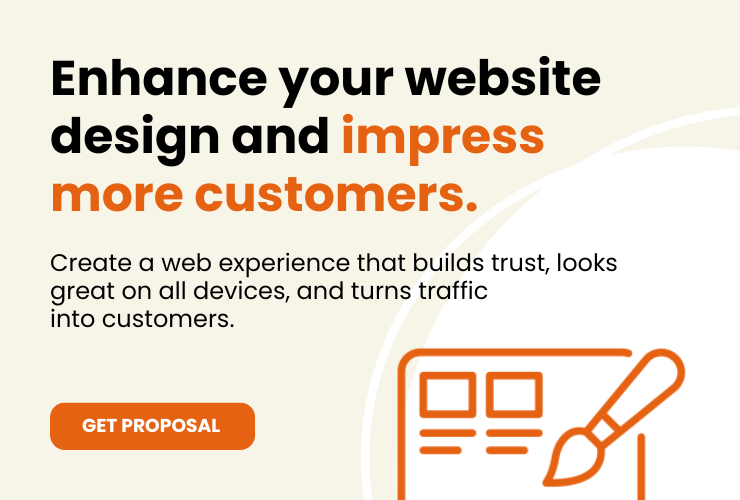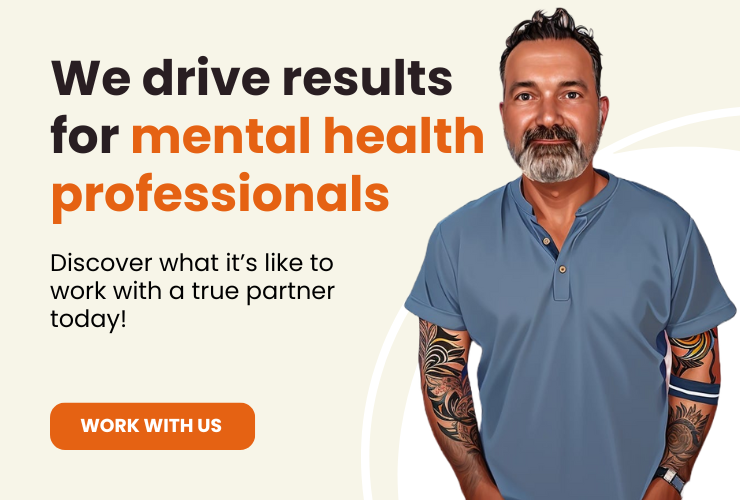Effective mental health website design is pivotal for professionals as it reflects their expertise, establishes credibility, and provides a supportive space for visitors to seek help, ensuring their initial digital interaction is positive and comforting.
When it comes to mental health website design, mental health professionals face the unique challenge of creating a digital space that is informative, reassuring, and safe.
An effective mental health website design should serve as a calming digital sanctuary, offering solace and clarity to those seeking support. It must blend intuitive navigation with empathetic aesthetics, creating a space where visitors can find help with dignity and ease. For the best results, your website design should inform your overall mental health marketing strategy.
In this article, you will discover everything you need to know about mental health website design.
Overview
Understanding the Impact of Website Design
The impact of website design transcends its visual elements, playing a crucial role in how users perceive and interact with your site.
Good design can effectively communicate your brand message, establish trust with your audience, and guide visitors through a journey that culminates in the desired action, whether it’s making a purchase, signing up for a newsletter, or scheduling an appointment.
It’s the delicate interplay of aesthetics and usability that makes a website not just a platform, but an experience that resonates with users.
The design of your website is often the first impression a visitor has of your brand – a well-executed design can make that first impression powerful and lasting. It’s about making an immediate connection with your audience, reflecting the essence of your brand, and ensuring that every interaction on the site reinforces the values and objectives of your business. The design of a website acts as the foundation of digital marketing for mental health professionals, so it's worth the investment of time to make sure it serves your brand effectively.
Creating An Enjoyable User Experience
An enjoyable user experience is the hallmark of a well-designed website. It’s created through a user-centric approach that anticipates visitors' needs and preferences, ensuring that the site is intuitive, engaging, and helpful.
This involves a seamless navigation structure, clear and compelling calls to action, and informative and easily digestible content. Speed is also a factor – users expect quick load times and a smooth, uninterrupted experience as they explore your site.
Moreover, an enjoyable UX is inclusive, considering the full spectrum of users, including those with disabilities, ensuring everyone can interact with your site effectively.
When a website is a joy to use, it leaves a positive impression and encourages users to return, fostering loyalty and increasing the likelihood of conversion. It’s about creating an environment where users feel understood and appreciated, which is crucial in healthcare, e-commerce, and service industries.
The Basics of Design Aesthetics
The basics of design aesthetics involve the elements and principles that contribute to the overall visual appeal and effectiveness of a website or any visual medium. These basics include:
- Color Theory: The strategic use of color to evoke emotions, convey messages, and create harmony or contrast on the website.
- Typography: Select and implement typefaces that enhance readability, establish hierarchy, and contribute to the site's personality.
Imagery: The use of high-quality, relevant images and graphics to support content, illustrate concepts, and engage users. - Layout and Composition: The arrangement of elements on a page to create balance, direct user attention, and facilitate a natural flow of information.
- Whitespace (Negative Space): The intentional use of empty space to prevent clutter, highlight important elements, and improve user experience.
- Visual Hierarchy: The design technique of organizing elements in a way that signifies their importance, often achieved through size, color, and placement.
- Consistency and Harmony: Ensuring a cohesive look across all pages through consistent use of colors, fonts, and design motifs.
- Simplicity and Clarity: Avoid overcomplicated designs that can overwhelm users, instead focusing on delivering a clear and concise message.
- Texture and Patterns: Utilizing textures and patterns to add depth and interest to the design without distracting from the content.
- Branding: Incorporating brand elements such as logos, color schemes, and style to ensure the design aligns with the brand identity.
These aesthetic elements must work together cohesively to create a visually appealing and effective design that resonates with the intended audience and reinforces the website's objectives.
The Basics of Design Functionality
The basics of design functionality refer to the practical aspects of a design that make it effective and user-friendly. Here are the key components:
- Responsiveness: The design must work well across different devices and screen sizes, adapting its layout and functionality for an optimal viewing experience.
- Navigation: It should be intuitive and straightforward, allowing users to find what they're looking for quickly, typically within three clicks or less.
- Load Time: Web pages should load quickly to reduce bounce rates and improve user engagement.
- Accessibility: The design should be accessible to all users, including those with disabilities, following the Web Content Accessibility Guidelines (WCAG).
- Interactivity: Interactive elements like buttons, links, and forms must function reliably, providing immediate and relevant feedback to user actions.
- Content Organization: Information should be organized logically with a clear hierarchy, making it easy for users to digest and understand.
- Search Functionality: A search feature can greatly enhance the functionality of a site by allowing users to bypass navigation for direct access to information.
- Multimedia Performance: Videos, images, and other multimedia elements should be optimized for fast loading and should not hinder the site's performance.
- Scalability: The design should be scalable, able to grow and evolve with the business without requiring a complete overhaul.
- Technical Robustness: The website should be built on solid coding standards, ensuring it is secure, performs well, and is future-proof against technological advancements.
Functionality is about blending the art of design with the science of user experience, ensuring that a website is not just aesthetically pleasing but also practical, efficient, and accessible to all.
The Importance of Accessibility & Compliance
Accessibility and compliance in mental health website design are not just legal imperatives but ethical ones, ensuring that services are reachable to all individuals.
Adhering to the Americans with Disabilities Act (ADA) and WCAG guidelines demonstrates a commitment to inclusivity, allowing those with diverse abilities to navigate your site with ease. Such measures foster trust and expand your reach, underscoring your role as a caring, professional provider in the digital age. Implementing accessible design features like alternative text for images and keyboard navigability shows consideration for every user’s experience.
This attention to detail is what sets your practice apart, signaling that you value every individual’s journey toward better mental health.
10 Mental Health Website Design Tips
Designing a website for mental health services is a delicate balance between professional functionality and compassionate presentation. It's essential to create a space that feels safe and inviting while providing easy access to vital resources and support.
Here are 10 mental health website tips to help you get started:
1. Use Consistent Branding
Consistency in branding across your mental health website is more than a design choice—it's a statement of your practice's identity and professionalism. The colors, fonts, and logos you choose should align with the emotional support and stability your service provides.
Opt for color schemes that convey tranquility and healing—blues and greens are often associated with calmness and can reassure visitors subconsciously.
Your logo should be a beacon of hope, prominently placed and consistent across all pages, reinforcing your brand with each click.
Fonts must be readable and evoke a sense of calm – avoid overly stylized text that may detract from the message.
Remember, every design element is a subtle communicator of your brand's values and mission, and consistency ensures that your message remains clear and comforting throughout the user's journey on your site.
2. Make Sure Your Design is Responsive to All Devices
In today's digital landscape, your audience will access your mental health resources from various devices, making responsive design an essential feature of your website.
A responsive website adapts fluidly to the screen size of smartphones, tablets, and desktops, ensuring that the layout, text, and interactive elements are always accessible and legible. This is not only about aesthetics but also about providing a seamless user experience that accommodates the diverse ways people seek help.
By ensuring that forms, contact information, and resources are equally usable on a small smartphone screen as they are on a large monitor, you're demonstrating an understanding of your user's needs and a commitment to providing support regardless of how they reach out.
3. Incorporate High-Quality Images and Video
The visual components of your website can speak volumes to your visitors. High-quality images and videos serve as a powerful means of connection, often conveying emotion and information more effectively than text alone.
For a mental health website, choose imagery that reflects diversity, inclusivity, and positivity. Avoid clichés and aim for authentic representations of the support and care your practice offers. Videos can offer a deeper insight into your services, allowing potential clients to get to know you before they commit to an appointment.
A welcome message from the clinician or testimonials from past clients can be especially impactful, providing a personal touch that still images cannot.
Ensure that all visual media is optimized for web use to maintain fast loading times and enhance overall user experience.
4. Create Easy Navigation
The navigation of your mental health website should be a guiding hand for visitors, not a hurdle. It's crucial to have a clear, well-organized menu that allows individuals to find information swiftly and effortlessly.
Categories should be logical, prioritizing the needs and expectations of the user. Drop-down menus can be effective but keep them streamlined to prevent confusion. The inclusion of a search function can also greatly aid in navigation, particularly for users looking for specific resources or services.
Remember, the less time a visitor spends trying to figure out where to go, the more time they have to engage with your content and services, which can lead to higher retention and conversion rates.
5. Provide Clear Calls to Action Across the Site
Calls to action (CTAs) are the signposts that guide your visitors through the journey of your website and encourage them to take the next step.
Whether it's to book an appointment, download a resource, or make a call, your CTAs should stand out and be consistent in style and language. Place them strategically throughout your website, especially where visitors make crucial decisions.
Ensure that your CTAs are action-oriented, using verbs like 'Call', 'Schedule', 'Download', or 'Learn More' to provide clear direction. A/B testing different CTA designs and placements can also be invaluable in determining what resonates best with your audience.
6. Create an Accessible Experience for Everyone
Accessibility should be a cornerstone of your website design, ensuring everyone, including those with disabilities, can access your content and services.
Use alt text for images, provide transcripts for videos, and ensure navigation is possible through keyboard and assistive technologies. Regularly check your website against the WCAG guidelines to ensure you meet or exceed the required standards.
This not only broadens your potential client base but also demonstrates your practice's commitment to inclusivity and care for all individuals, regardless of their abilities.
7. Include Contact Options Prominently
For individuals seeking mental health support, finding contact information quickly can be critical.
Ensure your contact details are easily accessible, not tucked away in a corner of your website. Include multiple contact methods—phone, email, contact forms, and possibly a live chat option—to cater to different preferences and needs.
Highlight these options in your header, footer, or as a floating element that remains visible as the user scrolls. This visibility provides reassurance and support to individuals, making the process of reaching out for help as simple and stress-free as possible.
8. Display Testimonials at Contact Points
Testimonials are a testament to the success and credibility of your services. Place them where potential clients are making decisions, such as near contact forms or on service pages.
Use real feedback from past clients (with their permission) to create an authentic and relatable endorsement of your work. Including a name, photo, or video can add an extra layer of trust and personal connection.
Highlighting positive experiences can be the reassurance someone needs to decide to seek help from your practice.
9. Avoid Clutter
A clean, uncluttered website design is essential for a mental health practice, where visitors may already be feeling overwhelmed.
Prioritize content and features that add real value to the user's experience and remove anything that could be a distraction. Use whitespace effectively to create a sense of calm and order, and organize content in a way that's easy to digest.
The goal is to create a serene online space where information is conveyed clearly and concisely, allowing visitors to focus on their needs without additional stress.
10. Work with a Professional Designer
A professional website design service will offer the expertise necessary to create a polished, functional, and accessible website.
They can ensure that your site not only meets all the technical requirements of modern web design but also aligns with the therapeutic nature of your services. A professional designer can help you navigate the complexities of user experience, ADA compliance, and branding, ensuring your website serves as an effective tool for both your practice and your clients.
Investing in professional design services can ultimately save you time and resources while delivering a superior product that stands out in the digital landscape.
Need Help with Your Mental Health Website Design?
Are you a mental health professional seeking to establish a strong online presence?
Look no further than Sachs Marketing Group, your full-service digital marketing agency that specializes in web design for mental health professionals. We excel in crafting bespoke website designs that resonate with the delicate nature of mental health services. With our tailored approach, your website will not only attract visitors but also offer them the solace and support they seek.
Contact Sachs Marketing Group today and watch your vision come to life.
Get a free, no obligation review of your digital marketing strategy!
"*" indicates required fields





